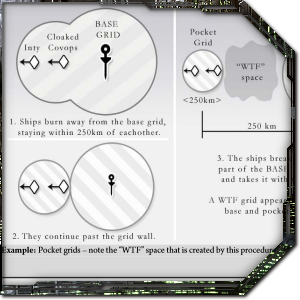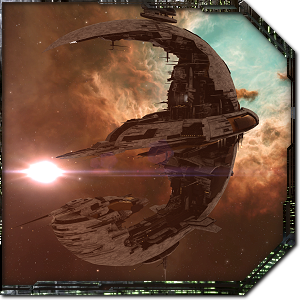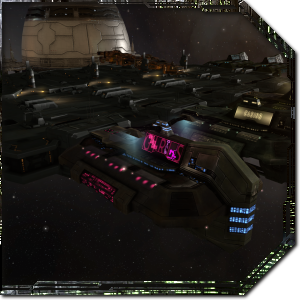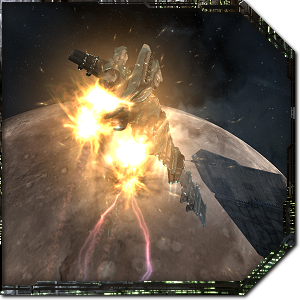
We’ll be able to build citadels close enough together that they’re only a few seconds warp from each other, but due to a quirk of how EVE divides its space up into small bubbles, structures and players more than 500km or so apart usually can’t even see each other. That’s the problem CCP is experimenting with right now, with grid sizes on the test server currently increased from around 500km in diameter to 8,000km or more. This would allow players to build communities of citadels in order to work together or to use them as huge battlefields where warring corporations can have staging citadels within visual range of each other. The change could have wide consequences for everything from territorial warfare to piracy and even industry, and it could be the first big step toward finally fixing corporation wars in high security space.
In this edition of EVE Evolved, I examine what increasing grid sizes would mean for EVE and propose some much-needed changes for the war declaration system that could soon be possible thanks to the Citadel expansion.
 What does grid size actually do?
What does grid size actually do?
Grids are essentially an optimisation technique that CCP uses to reduce the computation and bandwidth required by the server, and it’s a big part of the magic that has allowed EVE to remain a single-shard universe. Every stargate, planet, space station or other point of interest is basically contained within a 500km-wide bubble of space players refer to as a grid. When you warp to a stargate, the server detects that you’ve entered that bubble and only then begins sending you data on every object inside it.
Not only does this limit the amount of bandwidth the server consumes, but it also means players can’t use memory hacks to find out where players are in a star system as the server literally doesn’t send you that information until you warp in on top of them. In that way, the grid system stops you from seeing or interacting with objects more than a few hundred kilometers away, the exception being that things such as stations and planets can show up on the overview at long range.
If any significant grid size increase goes live, we’ll suddenly be able to see objects that are further away without using the complicated directional scanner. You’ll see enemies warping into your area much earlier, giving you a few extra seconds to react to incoming reinforcements. You’ll also be able to move fleets to locations further outside combat range without losing eyes on the target fleet. But most importantly, you’ll be able to build citadels within visual range of each other and see players docking and undocking at nearby citadels.
 Multi-citadel fights and grid sizes
Multi-citadel fights and grid sizes
We’ve already been told that Citadels must be a minimum of 600 km from any other object so that you can’t get overlapping zones of death between multiple citadels. With the current grid size, that means every citadel would be in its own little island bubble of space that’s visually cut off from nearby objects. If you put a citadel 600km from a space station or asteroid belt then you wouldn’t be able to see the station or belt from its location. Players visiting the asteroid belt might not even know your station is there unless they use the directional scanner, and players at two citadels 600km apart wouldn’t even see each other.
That sounds pretty disappointing and severely limits the potential for emergent gameplay, a problem I hadn’t really considered until I started thinking about the consequences of increasing grid sizes. Increasing the grid size means we can easily get multiple citadels in the same area of space, see what ships are sitting outside them, and quickly warp between them. It means corporations can stake claims to asteroid belts, set up their own market stations that are right next to NPC stations, or set up pirate waystations overlooking stargates they like to camp.
It also means that we’ll be able to plant citadels close enough together to have proper battles over them, and our player-built infrastructure can be integrated with NPC stations and stargates right from day one. I was previously struggling to see how highsec citadels could actually compete with NPC stations, but it’s all starting to make sense now that we know citadels can be conveniently located within visual range of existing points of interest.
 Highsec wardecs and competition
Highsec wardecs and competition
Jason Quixos over at Crozzing Zebras wrote a fascinating article recently on how he thinks Citadels could revolutionise highsec wardecs, and it really got me thinking. A war declaration is essentially a bribe that player-run corporations can pay the police to look the other way when they start attacking another corp. The attacker pays 50 million ISK or more to attack another corp for one week, and the defender gets just 24 hours notice before hostilities can commence. The original idea was to let highsec corps compete over resources or any reason they feel like, but the reality is very different.
Most players who are the subject of an unexpected war just log off for the week and don’t fight so that they put nothing at risk, and most warmongering corporations will move on to a more entertaining target if they don’t get their money’s worth out of the war fee. Jason asserts in his article that citadels will empower defenders to actually fight in a war as their citadel will be at risk if they just log off for the week, and I have to agree. A corp’s citadels will be located right where they live and it’s where their stuff is kept, so there’s incentive there to defend it. Powerful citadel weapons and the tethering invulnerability mechanic also make even a medium-sized citadel pretty damn defensible, acting as a force multiplier in PvP.
The main problems I see with wardecs are that the attacker risks very little and the defender has no way to win other than boring the enemy into submission or unexpectedly kicking his head in. I wrote an article on this a few years back in which I suggested that corps should be forced to put something on the line to initiate a wardec and the defender should be able to end the war early by capturing the attacker’s war chest. Now with citadels coming in, a variation of that system could actually be implemented and it would be pretty damn awesome.
 War declaration overhaul: A proposal
War declaration overhaul: A proposal
The current war declaration system amounts to a pay-to-grief system in which the attackers are incentivised to pick weak industrial targets and the defender’s best weapon is logging off for a week. To fix this, I propose that both the attacker and defender in a war must have a citadel. Player-run corps would only be vulnerable to a war if they actually have a citadel, and both the attacker and defender would have something on the line. To maximise the potential for an actual war and minimise abuse, CCP could make it so the attacker must plant their citadel in the same star system (or even in the same grid) as one of the defender’s citadels.
Both citadels would be locked down during a war so that they can’t be packed up and moved, and the war would automatically end as soon as one side destroys the other’s citadel. The asset safety system citadels will use means all of the items inside will be safely returned to their owners for a small fee, so there won’t be any loot. The incentive for the attacker to win a war would be to get some fights out of it and attack the corp’s members, while the defender’s incentive to win would be to end the war early. Defenders who just log off for a week during a war may deprive their attackers of easy ganks or fun fights but they’ll definitely lose their expensive citadel.
Under this system, soft targets such as newbie training corps who would never fight back in a war anyway would be able to essentially opt out of the war system by just not building any citadels. The ISK cost of wars would also no longer be necessary as the citadel itself is a considerable investment. Declaring wars on large corps and alliances also needn’t be more expensive as they’ll be much more capable of simply stomping your citadel into the ground. The winner of a war could also be given a portion of the destroyed enemy citadel’s build cost as an added incentive.
 The possibility of an increase in grid size may seem like an innocuous change that affects little more than how much notice we get of incoming enemies, but when combined with citadels it becomes something really exciting. Players will be able to build small communities of citadels together and easily integrate their structures with existing NPC infrastructure like space stations and stargates. The industrial activity of corporations may be much more visible rather than hidden away at moons and inside NPC stations, and communities may even band together for mutual defense.
The possibility of an increase in grid size may seem like an innocuous change that affects little more than how much notice we get of incoming enemies, but when combined with citadels it becomes something really exciting. Players will be able to build small communities of citadels together and easily integrate their structures with existing NPC infrastructure like space stations and stargates. The industrial activity of corporations may be much more visible rather than hidden away at moons and inside NPC stations, and communities may even band together for mutual defense.
Citadels will undoubtedly act as flashpoints for PvP and should even improve highsec wars, but they also open up the possibility of finally fixing the wardec system for the first time in EVE‘s history. If CCP takes the opportunity to tie wardecs to citadels then corporations might actually end up fighting wars rather than evading them, and everyone would be fighting for something other than just bragging rights and cheap ganks. That sounds pretty awesome to me, and we can only hope it sounds just as good to CCP.
 EVE Online expert Brendan ‘Nyphur’ Drain has been playing EVE for over a decade and writing the regular EVE Evolved column since 2008. The column covers everything from in-depth EVE guides and news breakdowns to game design discussions and opinion pieces. If there’s a topic you’d love to see covered, drop him a comment or send mail to brendan@massivelyop.com!
EVE Online expert Brendan ‘Nyphur’ Drain has been playing EVE for over a decade and writing the regular EVE Evolved column since 2008. The column covers everything from in-depth EVE guides and news breakdowns to game design discussions and opinion pieces. If there’s a topic you’d love to see covered, drop him a comment or send mail to brendan@massivelyop.com!













